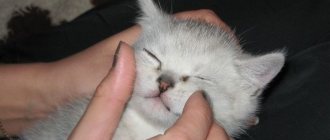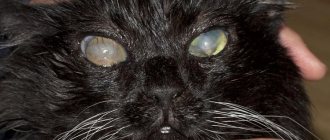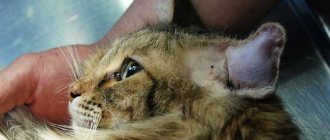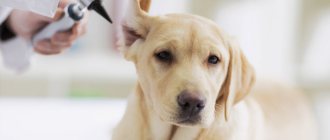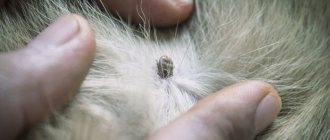Eyes are an indicator of a cat's health. The vital organ reacts sensitively to any external and internal stimuli. Before you get a pet, you need to know what pathologies can manifest in cats throughout their lives. First of all, pay attention to the condition of the eyes. They are covered externally by the upper, lower and third eyelids. The prevalence and type of disease, intensity, and the length of time that passes before the immune response appears influence the development of dysfunction of all organs. What eye diseases do cats have? We will talk about this in our article.
Eye diseases in cats: an overview
Healthy eyes in a cat
A healthy cat's eyes should be clear, without clouding, the whites should be light, and the eyelids should not be swollen. The discharge from the corners of the eyes is light and almost invisible.
Health problems are signaled by:
- swelling, redness and inflammation of the eyelids;
- lacrimation;
- discharge from the eyes.
Sick cats squint in the light, sometimes the third eyelid closes the eye.
A cat's affected eye is very different from a healthy one.
Physiological characteristics of the eyes in different breeds of cats
In some cases, eye discharge in cats is not a cause for concern. For example, in British and Scottish cats, due to the special shape of the skull, the tear ducts are often narrowed, so these breeds suffer from tearfulness.
A similar problem occurs in Persian cats, but in addition to narrowed tear ducts, they also have crooked nasal passages, so the discharge from the eyes may be brown. If the cat has received all its vaccinations on time, doctors recommend not to worry about this and to wipe the cat’s eyes daily with a cotton pad soaked in chamomile infusion or warm boiled water.
Due to the flat shape of the muzzle, Persian cats have altered tear ducts and nasal passages.
Clinical symptoms of inflammatory processes
The vast majority of diseases begin with exactly the same signs, when the cat’s condition worsens sharply:
- In the acute phase, an increased temperature is observed.
- Increased loss of fluid in the body.
- Complete lack of appetite.
- Lethargy and apathy.
When specific signs of pathology appear, it is most likely that there is a certain infection in the eyes. The precursors of eye diseases are the following:
- Eyelash growth inward.
- Inversions and inversions of the eyelid.
- Squinting and photophobia.
- The third eyelid extends half the eye or more.
- Swelling, redness, or clouding of the fundus of the eye.
- Lacrimation, other discharge and discharge from the eyes.
Entropion of a cat's eyelid
Symptoms are clearly visible on white fur, even if the eyes are treated with a solution. Only in the development of the process can clinical signs characteristic of each individual isolated disease be observed. If eye diseases are not treated in a timely manner, the animal’s condition worsens.
Eye diseases in cats
With all the variety of eye diseases in cats, they can be divided into two large groups:
- Damage and diseases of protective devices (eyelids and skin around the eyes).
- Diseases of the eye itself, or more precisely, the eyeball.
Diseases of the protective devices of the eye
Diseases of the eyelids are divided into:
- inflammatory (blepharitis);
- non-inflammatory (entropion, ptosis, trauma).
Blepharitis
Blepharitis is inflammation of the eyelids. Often cat owners confuse it with conjunctivitis, but this is not the same thing at all. There are several types of blepharitis:
- Scaly - got its name because of the grayish scales that appear at the roots of the eyelashes. After some time, if left untreated, the eyelashes fall out, and pus appears in place of the scales. In cats with this disease, the eyelids are red and swollen.
- Ulcerative - develops from scaly. After the pus dries, ulcers remain on the eyelids, through which infection can enter the body. As the ulcers heal, the resulting scar tissue often tightens the skin, causing entropion.
- Meibomian - characterized by inflammation and increased secretion of the meibomian glands, which are located on the edges of the eyelids. The disease appears when microorganisms penetrate the ducts of these glands, as a result of which the latter begin to secrete pus, and the edge of the eyelid thickens and turns red.
With blepharitis, the eyelids become swollen, red, and crusts and pus may appear on them.
Blepharitis can result from various causes:
- fungal infections, especially the causative agent of lichen;
- the development of pathological microorganisms, among which streptococci and staphylococci are especially active;
- allergies to food, plants, dust and any other pathogens (in this case, blepharitis is especially severe, the animal’s temperature rises, photophobia begins, it rubs its muzzle against furniture and can further damage the eye);
- parasitic infestations, especially tick-borne ones;
- mechanical damage, for example, scratches received in a fight;
- autoimmune and endocrine diseases;
- surgical intervention to transplant salivary glands is a rather rare manipulation that surgeons perform in case of insufficiency of the function of the lacrimal glands in cats (the malaise in this case is caused by the fact that salivary enzymes aggressively act on the delicate skin of the eyelids).
The veterinarian performs a slit lamp examination, takes blood tests and a biopsy of the skin of the eyelids, and then prescribes treatment depending on the cause of the disease.
Usually it proceeds according to the following scheme:
- The edges of the eyelids are disinfected with an antiseptic.
- A gentomycin or methyluracil suspension is injected into the conjunctival sac.
- Crusts and scales are softened with Vaseline and carefully removed.
- Drops are put into the eye.
- If a fungus is detected, fungicidal ointments and three-stage vaccination are used.
- If the disease is caused by microorganisms, antibiotics to which they are sensitive are prescribed in ointments or injections.
Home remedies alone cannot cure blepharitis, but they will be a good addition to the therapy prescribed by your doctor. It is recommended to wash your cat's eyes daily with a decoction of chamomile, hyssop, sage or calendula, and also use special Phytomins for the eyes, which are added to food.
Phytomins are a large series of veterinary products made from natural raw materials and designed to solve various problems that arise in cats and other pets.
Entropion of the eyelids
With this disease, the outer edge of the eyelid turns inward, and the hair and eyelashes covering it injure the cornea of the eye. Most often, Sphynxes, Persians and Britons suffer from entropion, but other breeds are not immune to this pathology. Various reasons lead to inversion of the eyelids:
- a congenital defect in the development of the eyelids, in which they grow too long;
- mechanical damage to the eye during play or fighting with other animals;
- a scar formed after healing of an injury or burn;
- facial paralysis;
- age-related changes, loss of skin and muscle elasticity;
- spasm of the muscles surrounding the eyes;
- neoplasms or foreign bodies in the eye.
The lower eyelid rolls up much more often than the upper eyelid
Symptoms of entropion may appear mild at first, but if the disease is not treated immediately, they will increase. The most common signs include:
- redness of the eyes;
- reduction or change in the shape of the palpebral fissure;
- photophobia;
- lacrimation;
- abundant formation of pus in the eyes.
The animal may also squint and rub its eyes with its paws. If these signs appear, the cat should be taken to the doctor immediately.
Treatment proceeds as follows:
- The veterinarian takes blood tests, urine tests, and an electrocardiogram to make sure the cat will tolerate the anesthesia.
- The animal is not fed 12 hours before surgery.
- After putting the cat under anesthesia, the veterinarian cuts off an extra piece of skin from the eyelid and fixes the remaining part in the desired position with a surgical suture.
Entropion of the eyelids in cats is corrected surgically
- If the cornea is severely damaged, it is covered with a third eyelid, which promotes healing, and tetracycline ointment is applied.
At home, the owner must treat his pet's eyelids with antibiotic ointment for ten days, after which the suture is removed in the clinic. In almost all cases, the cat makes a full recovery.
Ptosis
Ptosis is an involuntary drooping of the upper eyelid. With this disease, the cat cannot fully open its eyes, the eyelid does not rise voluntarily, and the palpebral fissure narrows.
Ptosis is a disease that causes drooping of the upper eyelid
Its causes are very similar to those that cause entropion:
- facial paralysis;
- weakness of the orbicularis oculi muscle;
- complications of inflammatory diseases.
Accordingly, surgical treatment is carried out in the same way as the treatment of entropion.
Lagophthalmos
In appearance, an eye affected by lagophthalmos may resemble the eye of a cat with ptosis. The palpebral fissure is narrowed, but the animal cannot completely close the eye and also suffers from lacrimation.
The causes of lagophthalmos can be:
- facial paralysis;
- scars that remain after bloat or blepharitis;
- congenital pathologies.
Treatment of lagophthalmos is exclusively surgical.
Other diseases
Less common eyelid diseases include:
- ankyloblepharon - fusion of the eyelids, or failure to open the eyes in kittens, can be caused by early conjunctivitis;
- symblepharon - fusion of the eyelids with the conjunctiva of the eye;
- prolapse of the third eyelid - prolapse of the lacrimal gland.
Prolapse is a disease in which the lacrimal gland of the third eyelid loses its normal anatomical position, falls out of the conjunctival sac and becomes noticeable as a pink, round formation in the inner corner of the palpebral fissure.
For these diseases, only surgical treatment is indicated.
Diseases and damage to the eyeball itself
Lesions of the eye itself are more dangerous than diseases of the eyelids, as they more often lead to blindness. They can also be divided into inflammatory (conjunctivitis) and non-inflammatory (glaucoma).
Conjunctivitis
Conjunctivitis is one of the most common eye diseases in cats. This is partly due to the fact that it can be caused by many reasons, including:
- viruses, bacteria and fungi, and if fungi infect the conjunctiva, then the viral infection can be generalized;
- allergens - cause inflammation of the conjunctiva, as well as symptoms such as itching, runny nose, watery eyes and sneezing;
- mechanical damage - serves as an entry gate for infection;
- parasites, or rather, toxins released by them into the internal environment of the body;
- colds and weakened immunity;
- ultraviolet radiation (UV lamps, LED lamps for polymerization of gel polish).
With conjunctivitis, cats' eyes become cloudy and their eyelids swell
There are several types of conjunctivitis, which, if left untreated, can transform into one another, and the course of the disease becomes more complicated:
- catarrhal conjunctivitis is characterized by mucous discharge, swelling and lacrimation, it is easy to get rid of if treatment is started immediately;
- purulent is easily recognized by yellow-green discharge that accumulates in the corner of the eye and on the fur under it, the eyelids can stick together, it is dangerous for complications such as keratitis and panophthalmitis, which can lead to blindness;
- phlegmonous - with this type of conjunctivitis, pus not only comes out, but also accumulates intradermally, so it is much more difficult to get rid of it;
- follicular - inflammation and protrusion of the follicles that are located on the inside of the eyelid; this is a chronic disease that requires long-term and intensive treatment.
Treatment of conjunctivitis is determined by the veterinarian depending on the cause and type of the disease, but usually it occurs in several stages:
- The veterinarian washes the eye with furatsilin solution. After this, at home you need to wash the cat’s eyes every 3-4 hours with black tea or a decoction of chamomile or calendula.
- After washing behind the eyelid, or in extreme cases, an antibacterial ointment is applied to the eyelid.
- Also, after each wash, drops prescribed by the doctor are instilled.
- If purulent, phlegmonous or follicular conjunctivitis is diagnosed, it is necessary to inject antibiotics intramuscularly; in case of an allergic variant, the animal is given antihistamines.
- After treating your cat's eyes, you must wash your hands, since animal conjunctivitis is contagious to humans.
Keratitis
Keratitis is an inflammatory disease in which the cornea of the eye becomes cloudy. There can be many reasons for this:
- mechanical damage to the cornea due to impact or foreign bodies;
- corneal burns;
- infectious diseases affecting the body as a whole;
- inflammation of the lacrimal glands;
- avitaminosis;
- herpes virus;
- diabetes;
- chronic renal failure;
- conjunctivitis (keratitis can develop based on it).
Keratitis is easily recognized by the fact that the cornea becomes cloudy
The symptoms of keratitis appear very quickly, and it is almost impossible not to notice them:
- the cornea of the eye loses its transparency and can grow blood vessels;
- Fluid accumulates under the cornea and it bulges;
- discharge of mucus and pus from the eye appears;
- The cat suffers from photophobia.
First of all, the veterinarian must identify the cause of keratitis and, depending on it, prescribe treatment:
- if keratitis is caused by a fungus, long-term fungicidal ointments are indicated;
- for viral keratitis, drugs containing interferon are used;
- in case of bacterial infection, antibiotics and sulfa drugs are prescribed;
- for allergic keratitis, antihistamines help;
- Bullous keratitis, characterized by the appearance of bubbles with liquid, is treated with Solcoseryl ointment.
Glaucoma
Glaucoma in cats, as in humans, is characterized by increased intraocular pressure and subsequent degenerative changes in the retina and optic nerve. The development of this pathology is caused by:
- arterial hypertension;
- age-related changes;
- untreated chronic diseases;
- congenital developmental pathologies;
- diabetes;
- genetic predisposition;
- long-term use of hormonal drugs.
Symptoms of glaucoma are:
- redness of the eyes;
- lacrimation;
- increase in eye size;
- constant dilation of the pupil with lack of reaction to light.
In glaucoma, the pupil in the affected eye is dilated and does not respond to light.
For glaucoma, medications are prescribed to reduce intraocular pressure, but the desired effect can only be achieved through surgery. Glaucoma surgeries are now performed using lasers.
Other eye diseases
Less common diseases that cat owners sometimes encounter include:
- exophthalmos - loss of the eye from the orbit due to the open structure of the orbit in cats, can be caused by infection or neoplasm;
- enophthalmos - retraction of the eye into the orbit; it can also be caused by a tumor or inflammation;
- microfalm - pathological reduction of the eyeball, often congenital, can appear in kittens whose mother was treated with teratogenic drugs during pregnancy;
- proptosis - complete loss of the eyeball, to which Persian cats are predisposed; in some cases the eye can be straightened, in others it is necessary to resort to removal;
- uveitis is a lesion of the choroid of the eye, in which the iris is involved in the process and is treated with great difficulty;
- iritis - inflammation of the iris and ciliary body, which can be treated with ointments and antibiotic drops;
- dermoid is a very rare disease in which the eye grows with skin tissue containing hair follicles; surgical removal of the altered areas is indicated;
- atrophy - compression of the eyeball, in which its removal is indicated.
Possible causes of inflammation
An infectious disease can provoke the development of the problem. Often such changes are observed as a result of injuries.
The disease also manifests itself when basic hygiene standards are not observed.
Physiological factors
Severe inflammation often develops due to the following reasons:
Foreign body. Tearfulness and redness may occur when a small pebble or speck hits the skin. One eye is affected. The second one remains in good condition. The area around the eyeball swells slightly. The appearance of yellowish or red discharge is possible.- Irritation. The problem is caused by tobacco smoke, cosmetics, and dust. The animal experiences severe itching and begins to blink more often. The owner notes that the cat’s right and left eyes are red.
- Injuries. Redness in the corner of the eye or the entire eyelid is observed after injury. For example, during a fight with another cat, as a result of damage to the mucous membranes by plants or small stones. In this case, excessive lacrimation is observed, pus appears, and blood may be released. The animal's eyelids swell, the eye becomes cloudy, and itching is noted. Even the development of blindness is possible.
Infectious diseases
Inflammation is often provoked by various infections:
Conjunctivitis. It can occur in chronic and acute forms. When a cat becomes ill, it loses its appetite and develops a fever. The eyes turn red and pus is released.- Cataract. Clouding of the lens occurs and vision deteriorates significantly. If the pathology is not treated in a timely manner, blindness occurs.
- Keratitis. The disease is characterized by symptoms such as photophobia, excessive tearing, purulent exudate, and redness of the eyelids. The cornea changes its shade.
- Blepharitis. With inflammation, the eyelids swell, the eyes turn red, there is copious discharge of pus, the eyelashes stick together, and ulcerations of the edges of the eyelids form. The cat is suffering from severe itching, and a rise in temperature is possible.
Failure to comply with hygiene standards
If the owner does not keep his pet's eyes clean and does not adhere to basic standards, the animal increases the risk of negative changes.
A favorable environment is created for the development of pathogenic organisms. As a result, their activation and the onset of the inflammatory process.
What symptoms require urgent veterinary help?
A healthy cat's eyes should be clean, shiny, wide open, and the animal should not rub them frequently with its paw. Any of the following symptoms is a reason to consult a doctor immediately:
- redness, swelling, or thickening of the eyelids;
- discharge of mucous, purulent or bloody contents from the corners of the eyes;
- lacrimation;
- photophobia;
- lack of pupillary reaction to light;
- itching, causing the cat to rub its eye with its paw or rub its muzzle on objects;
- inability to fully open or close the eyelid, frequent blinking of one eye;
- foreign bodies in the eye, neoplasms on the eyelids;
- cloudy or red eyes;
- creeping onto the eye of the third eyelid;
- wounds, burns or bruises of the eyes and eyelids;
- soreness to touch.
Blepharitis
A disease that causes inflammation of an animal's eyelids. Often confused with conjunctivitis due to similar symptoms. To understand how to treat this eye disease in cats, you first need to determine the type and cause of the disease.
There are three types of this pathology:
Meibomian - occurs due to the penetration of pathogenic microorganisms into the ducts of the meibomian glands. As a result, inflammation begins, the eyelids turn red, tearing increases and purulent discharge appears.
Scaly - inflammation with the appearance of scales on the eyelids, which leads to loss of eyelashes and purulent discharge if left untreated.
Ulcerative is a disease that develops from scaly without the necessary treatment. After the purulent masses dry out, ulcers appear on the surface of the eyelids, and when they heal, scar tissue forms, tightening the skin and causing entropion of the eyelids.
If the causative agent of blepharitis is an infection, then antibiotics in the form of injections or ointments are used for treatment. Fungal blepharitis is treated with fungicidal ointments.
In addition, it is necessary to treat the surface of the eyelids themselves. To do this, they are treated with an antiseptic, the scales at the roots of the eyelashes and dried pus are softened with Vaseline, after which they are removed and special drops are instilled into the eyes.
In addition to the medications prescribed by the veterinarian, it is necessary to rinse the eyes to remove purulent discharge and scales that form.
Rinsing is done with a warm decoction of chamomile or calendula. It is also necessary to add phytomins for the eyes and fortified supplements to the cat's food.
Medicines used for eye diseases in cats
The main forms of release of drugs prescribed for the treatment of eye diseases are ointments and drops. They also differ in their scope of action - some are active against bacteria, others against viruses and fungi.
Table: drugs used for different types of eye lesions
| Indication | Drugs | Operating principle | Application | Price |
| Inflammatory diseases | Tsiprolet | Ciprofloxacin has a bactericidal effect on streptococci and chlamydia | To prevent complications after surgery | 50–80 rub. |
| Diamond eyes | Contains chlorhexidine and taurine, has an anti-inflammatory effect | Degenerative changes in the retina, cataract prevention | 150–210 rub. | |
| Bacterial infections | Leopard | Levomycetin and furatsilin have a bactericidal effect on a wide range of microorganisms |
| 130–170 rub. |
| Iris | Gentamicin sulfate eliminates infectious agents |
| 160–200 rub. | |
| Levomycetin | Active against microorganisms resistant to penicillin |
| 10–30 rub. | |
| Viral infections | Anandin | Glucaminopropylcarbacridone in the composition is effective against chronic and acute viral infections |
| 45–190 rub. |
| Mechanical damage | Traumeel | Has an anti-inflammatory effect, relieves pain |
| 400–500 rub. |
| Fungal infections | Tetracycline ointment | Antibiotic with a broad spectrum of action, active against bacteria, fungi, protozoa |
| 50–250 rub. |
Most often, the drugs are not used separately; drops are usually combined with ointment and eye wash. Some products are multifunctional, for example, Iris drops can be used for almost any disease. The combination of medications is selected by the veterinarian in each case individually.
Photo gallery: medications for eye diseases
Tsiprolet - ophthalmic drops indicated for a number of diseases and visual defects
Bars eye drops are a combined antimicrobial drug intended for the care of animal eyes.
Tetracycline ointment is a broad-spectrum antibiotic
Anandin - veterinary eye drops used for the treatment of rhinitis and conjunctivitis in animals, an immunomodulator
The best drugs for treatment
For treatment to be as effective as possible, you need to choose proven means.
Iris
Gentamicin is the active substance in the composition. Kills anaerobic and protozoan bacteria. Prescribed for conjunctivitis, keratitis, blepharitis and corneal erosion. Instilled under the conjunctiva 4 times a day. Course duration – 7 days. Cost: 150 rubles.
Leopard
Chloramphenicol and nitrofural destroy bacteria, microorganisms and viruses. Prescribed to prevent the development of infections due to mechanical damage, for the treatment of acute and chronic forms of conjunctivitis. Before use, clear the eye of purulent discharge, course – 1.5 weeks. Cost: 80 rubles per bottle.
Levomycetin
Antibiotic. Eliminates any infectious agents. Has a wide range of applications:
- blepharitis;
- keratitis;
- infected injuries to the eye area;
- any types and stages of conjunctivitis.
Drop onto the eye 3 times a day. The course of treatment is 5-7 days. Can cause side effects - burning, redness of the eyeball. Price: 10-15 rubles.
Folk remedies for treating eyes in cats
In cases where going to the doctor and buying medications is not possible, you can resort to home remedies. Typically used:
- tea - brew a tablespoon of black tea with a glass of boiling water, let it cool, soak a cotton pad in the brew and wipe the sore eye with it;
- elderberry infusion - pour 10 grams of dried elderberry into 100 ml of boiling water, let it brew for 45 minutes, then strain;
- infusion of celandine - chop 5 leaves of the plant and pour two tablespoons of boiling water, let it brew for half an hour and strain;
- infusions of calendula, chamomile or St. John's wort - pour 2 tablespoons of dried leaves with a glass of boiling water, leave for 15 minutes and then strain;
- aloe leaf juice - grind 2-3 pieces in a blender and strain the juice through cheesecloth.
All means are used according to the same scheme:
- Soak a cotton pad in the liquid and gently rub it over the eye from the outer corner to the inner.
- After each pass, the disk is replaced with a new one.
- Both eyes need to be treated, even if one of them looks healthy.
The cat's eyes must be wiped from the outer corner to the inner corner to avoid the spread of infection to healthy areas.
There is often advice on the Internet to wipe a cat's eyes with olive oil, but veterinarians categorically do not recommend doing this, since a film of oil can create favorable conditions for the proliferation of microorganisms.
Folk remedies are only suitable as a temporary measure to alleviate the animal’s condition; for a complete recovery, treatment prescribed by a doctor is still necessary.
Video: veterinarian shows how to properly treat cats' eyes
What to do if a cat has watery eyes?
First you need to check if anything is stuck inside. Wool, slivers and blades of grass can be seen without much effort just with your eyes. If nothing is found, it is worth trying to examine the affected eye with a magnifying glass.
The eye may become watery because the wing of an insect or a small piece of film is stuck in it. They cannot be seen without special tools, but you can try to wash them like any other item.
Rinsing is best done with saline or ophthalmic rinsing solutions.
You should not wash your eyes with tea - it contains tanning substances that have an irritating effect on the mucous membrane. In mild cases that will go away on their own, tea is simply useless, and in severe cases it can cause complications.
How to properly wash out a watery eye
It is most convenient to carry out this procedure with an assistant who will hold the cat - two hands are usually not enough. The cat is wrapped in a towel or blanket so that it cannot escape or scratch, and the assistant sits it on its knees, with its back to itself.
Using two fingers, open the eye as much as possible, pour a warm sterile solution from a pipette into the upper outer corner, so that it flows down the mucous membrane to the inner corner.
Typically, debris that gets into the eye is washed off with 5-7 ml of liquid.
After washing, clean the inner corner of the eye with a corner of a sterile napkin soaked in saline solution.
They wash the eyes not only if they suspect a foreign object, but also when treating inflammation - this saves medications and speeds up recovery.
Rules for carrying out medical procedures at home
In order for eye treatment products to work as effectively as possible, you need to follow the rules:
- If the discharge has dried and stuck together the cat's eyelids, you need to carefully soak the crusts. To do this, just apply a cotton pad soaked in warm boiled water to your eyes several times, after which you can gently spread your eyelids with your fingers.
- Then you need to rinse the eye, pouring it with an infusion of herbs or a pharmaceutical product from a syringe or applying a generously moistened cotton pad.
- After washing, you need to drip drops, fixing the cat's head and moving the lower eyelid, or apply ointment.
- If your cat rubs his eyes with his paws, you should put a protective collar on him.
To prevent the cat from touching its eyes with its paws, a special protective collar is put on it.
- After the procedure, you must wash your hands thoroughly.
The cat's eye is watery due to breed characteristics
Constantly flowing tears stain the fur, irritate the skin of the eyelids and muzzle, and can cause eczema and ulcers. It will not be possible to remove tears if the pet has an obstruction or narrowing of the nasolacrimal duct from birth; it will not be possible to cure lacrimation either on your own or with the help of a veterinarian. In such cases, you can only try to reduce the harm from the problem.
To do this, the rusty strips of the tear ducts are blotted with a clean, dry cloth, and then an ointment is applied to protect the fur and skin. Breeders and veterinarians recommend using zinc ointment - it is inexpensive and effective.
There is no point in putting eye drops in such cases, as there is already an excess of tear fluid there.
Caring for cats with eye diseases
A sick cat requires special care to alleviate its condition:
- It is better to cut off the tips of the claws with special tweezers so that the animal does not accidentally touch the eyes;
- dehydration worsens the body’s condition, so if the cat refuses water, you should give it water from a pipette or wet its lips;
- the coat, especially long hair, needs to be combed more often than usual, since it can become matted from lying for a long time; you should not bathe your pet during this period;
- if the cat is prescribed antibiotics, stomach upset may occur, so it is worth starting a course of prebiotic;
- eliminate irritating factors in the room where the animal is located - dust, bright light, other animals;
- During the course of treatment, the cat should not be allowed outside.
Symptoms
However, the relationship between age and clinical manifestations is not so significant: yes, as a rule, kittens and old cats with weakened immune systems get sick . But given the number of latent carriers, any animal can suddenly show symptoms of infection just because the pathogen is activated by stress or other unfavorable environmental factors.
So, how can you determine the onset of the disease? First, the animal’s eyes turn red, the conjunctiva noticeably swells and turns red. As we have already said, exudate with a viral etiology of the disease is most often liquid and watery. If the pathology is complicated by pathogenic and conditionally pathogenic bacterial microflora, the exudate can become mucous or mucopurulent. Mild rhinitis may also occur. In the normal course of the disease, there are no corneal lesions. A thorough medical examination may reveal the initial stage of papillary hypertrophy on the surface of the conjunctival tissue.
If the disease is not treated, then after about two weeks the hyperemia of the affected organ gradually subsides, the tissues of the affected organ turn pale.
Features of the treatment of eye diseases in pregnant cats and kittens
Infectious diseases in pregnant cats are dangerous due to the possibility of abortion or stillbirth of kittens. If signs of eye disease appear, you should immediately consult a doctor and get tested to identify the pathogen.
The veterinarian prescribes antibiotics intramuscularly to cats during pregnancy with great caution, since many of them have teratogenic activity, and does this only if the risk to the cat’s health outweighs the risk of giving birth to sick kittens. Most often, pregnant cats are given Iris drops in their eyes, and sometimes tetracycline ointment is placed behind the eyelid.
Treatment of kittens differs from therapy prescribed to adult cats, only with a reduced dose of the drug. After recovery, it is necessary to give the kitten anthelmintic and receive age-appropriate vaccinations.
Keratitis
Damage to the cornea, which is accompanied by inflammation and clouding of the eye. The most noticeable symptoms of keratitis:
- accumulation of fluid under the cornea;
- copious mucous and purulent discharge;
- clouding of the cornea of the eye. In some cases, germination of the cornea by blood vessels is possible.
- corneal damage. This can be mechanical damage as a result of injury, foreign body, or chemical damage or burn;
- infections and infectious diseases that become the basis for the development of other diseases;
- viruses;
- decreased cat immunity, vitamin deficiency and metabolic disorders.
Treatment of keratitis occurs only under the supervision of a veterinarian after identifying the cause of keratitis.
Ringworm in cats - main signs, symptoms, prevention and treatment of ringworm in cats (105 photos)Pancreatitis in cats: first symptoms, nutritional nuances and treatment options (125 photos and videos)
Subcutaneous mites in cats - first symptoms, treatment options and real photos of examples of parasite damage (110 photos + video)
If the causative agent of keratitis is an infection or a virus, antibacterial and antiviral drugs based on interoferon are used.
Diseases not related to the eyes
Some symptoms common to eye diseases in cats can sometimes be a sign of other dangerous conditions:
- photophobia, a desire to hide in a dark place, sometimes appear in pregnant cats, as well as in animals under stress, for example, due to moving or the appearance of other animals in the house;
- photophobia can also be a symptom of rabies, although usually in this case it is combined with aggressive behavior, convulsions, foam at the mouth;
- viral diseases such as panleukopenia or calcivirus may cause the cat to avoid bright light;
- heat stroke can cause redness in the whites of the eyes in cats;
- if your cat's eyes are red, remember if you have recently bathed her; perhaps soap or other irritants got into her eyes;
- mycoplasmosis and chlamydia can also cause red eyes;
- lacrimation may be the cause of helminthic infestation;
- If you have a cold, you may also experience profuse discharge from the corners of the eye;
- Older cats experience watery eyes in windy weather.
Types and classification of eye diseases
Eye diseases in cats are a broad and multifaceted group of diseases. Pathologies are conventionally divided into two types:
- Non-inflammatory (non-infectious) diseases.
- Inflammatory (infectious) diseases.
Table. Common eye diseases in cats
| Non-communicable diseases | Infectious diseases |
| Cataract | Keratitis |
| Mechanical damage | Glaucoma |
| Drooping of the upper eyelid | Panophthalmitis |
| Retinal disorder | Conjunctivitis |
| Eversion and non-closure of eyelids | Inflammation and ulcer of the cornea |
| Foreign body entry | Neoplasms of the conjunctiva |
The list of inflammatory eye diseases in cats includes types of keratitis: superficial, superficial vascular, deep and purulent. Some cat breeds have a fold on their cheeks that injures the cornea of the eye. Then breed keratitis occurs, which must be prevented and treated.
Video - Eye diseases in cats
Infectious diseases
Most of the troubles for cats are caused by infectious diseases that occur in severe forms. A very important and distinctive point of all infectious eye diseases is the incubation period from the moment of infection by the pathogen until the manifestation of symptoms noticeable to cat owners and veterinarians.
Viruses are capable of mass distribution between animals and can be transmitted by airborne droplets from an infected to a healthy organism. Based on the nature of the pathogens that cause eye diseases, there are several types of microorganisms:
- Viral.
- Fungal.
- Protozoans.
- Bacterial.
Most of the troubles for cats are caused by infectious diseases that are severe.
The most important are the viral and bacterial group of infections.
Prevention of eye diseases in cats
In most cases, preventing eye diseases is much easier than treating them. To do this, just follow a few rules:
- Vaccinate against viral diseases of cats annually;
- if the cat is being walked, after each walk it is necessary to examine the eyes for the presence of foreign bodies and lacrimation;
- cats, especially long-haired ones, need to be brushed regularly, as hair can also get into the eye;
- carry out deworming every 3-4 months and periodically give your pet vitamins;
- avoid contact with stray animals;
- Regularly treat your animal's eyes with a special lotion.
Trauma or foreign object in the eye
If a kitten's eyes protrude from their sockets, this indicates that the eyes are poorly protected and are at additional risk of injury. Most often occurs in the summer when dry grass appears. Especially often, young pets with damage to the visual organ are brought to see an ophthalmologist. Eye injuries vary in severity:
- Bumps and bruises.
- Concussion injuries.
- Burns of various types.
- Internal and external wounds on the cornea of the eye.
- Penetration of foreign bodies and blunt objects into the eye.
If your eyes hurt due to a mechanical injury, you will need immediate help from your doctor. As first aid, the eyes are washed with clean water at room temperature or with special ophthalmic antiseptics. It is necessary to monitor the tear flow so that the liquid flows to the nose. A light bandage using sterile gauze is applied to the injured eye. It is slightly moistened with water or an ophthalmic septic tank.
Only a veterinarian can adequately help an animal.
Some household chemicals and home renovation products can cause eye burns. By blocking access to repair work sites, your cat can be protected from various burn injuries. Regarding eye injuries, it is impossible to give advice for all situations. Hidden injuries sometimes occur when animals are contused. Only a surgeon can assess the severity. It is important to follow all subsequent doctor's recommendations.
Classification of mycoses
Mushrooms are a whole separate kingdom of living microorganisms that inhabit our planet. Hundreds of their pathogenic species can infect not only animals, but also humans.
Based on the location of the fungus in the cat’s body, all types of diseases they cause are conventionally divided into two groups: superficial (affecting the skin and mucous membranes) and systemic (affecting the internal organs of the animal).
The fungal infections most commonly diagnosed in cats are:
- Ringworm (trichophytia, microsporia). Fungi multiply in grass, hay, soil contaminated with manure, and parasitize vegetables, plant leaves, and tree bark. They show increased sensitivity to ultraviolet radiation and some types of antiseptics. Animals that have suffered the disease remain infectious to other animals for a long period of time, since the spores of the fungus are extremely tenacious and remain virulent outside the skin (on the fur).
- Malassezia (ear fungus in cats) is a disease caused by a yeast-like pathogen that lives in moderate quantities on the body of all healthy animals. Under favorable conditions, it begins to actively reproduce. It loves warmth and humidity, so it often settles in the ears, armpits, and inguinal folds. It is necessary to differentiate the disease from ear mite damage.
- Aspergillosis is a dangerous fungal infection that affects the nasal cavity, lungs and intestines of cats. Often leads to inflammation of the nasopharynx and pneumonia.
- Candidiasis is a fairly rare disease for cats. In most cases it is a complication of other ailments. The fungus is localized on the mucous membranes and can cause diarrhea, weakness, and depressed state of the animal.
- Cryptococcosis is a common infection that affects many pets. This type of fungus in cats is mainly localized in the nasal cavity, but can multiply in the digestive tract, on the skin, and mucous membranes. In advanced cases, it affects the nervous system.
This is not a complete list of fungal infections that can undermine a cat’s health. Rarer types include eumycotic mycetoma, phaeohyphomycosis, rhinosporidiosis and others.

